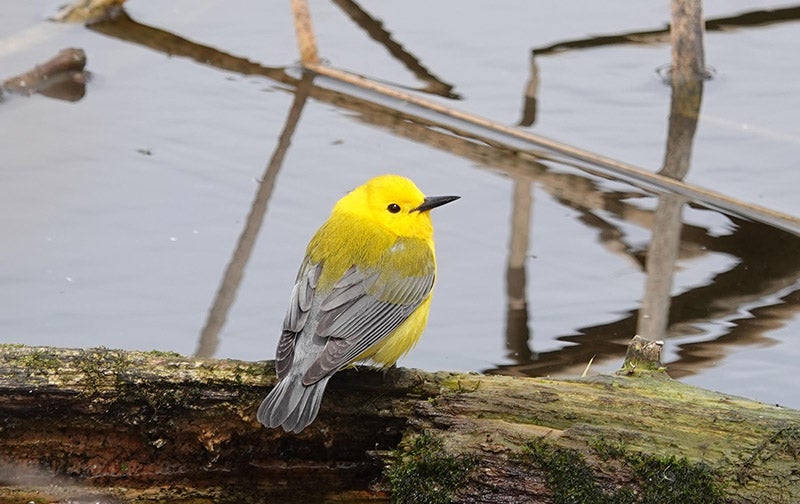Al Batt: Cluster flies of a feather: earthworm parasite named for its behavior
Published 9:00 am Saturday, May 12, 2018

- The prothonotary warbler played an important role in the Alger Hiss espionage trial from 1948 to 1950. - Al Batt/Albert Lea Tribune
Al Batt of Hartland is a member of the Albert Lea Audubon Society. Email him at SnoEowl@aol.com.
My neighbor Crandall stops by.
“How are you doing?” I ask.
“Everything is nearly copacetic. Avoiding road construction and potholes should be an Olympic event. I took inventory of the cash in my billfold. It didn’t take long. I’d like to buy a new truck, but I don’t have that kind of money handy. I don’t even have that kind of money unhandy. Even so, life is good, and I laughed all the way to the bank, except for when I stepped in that hot tar. I’m not overweight. I’m just easy to see. I stepped on the bathroom scale this morning. The numbers weren’t good, but I’m not worried about them. I demanded a recount. Hey, you know about insects. What kind of huge insect is yellow with black horizontal stripes, purple eyes, green wings and a gigantic stinger?”
“I’m stumped. I have no idea,” I say.
“You should find out. It just crawled down your neck.”
Naturally
I was awakened at daybreak by whistling rose-breasted grosbeaks and drumming woodpeckers. It was a more pleasant way to join the world than by hearing a strident alarm clock.
A skunk had met its demise on the road not far from my front door. The fetid smell assailed my olfactory sense. I took a deep breath and chipped a tooth.
It loves to wander, but my mind was prepared to wonder. I saw flying dandelions. I didn’t see as many of those goldfinches in my yard this winter as I do most years. I welcomed their brightened plumage.
I took some photos. I reminded myself that cameras are to take bad photos, too. I took a long walk on the Blazing Star Trail in Albert Lea. A prothonotary warbler posed patiently and perfectly for this flawed photographer. For that and other things, I am most grateful.
I watched a fox squirrel eat the buds of a tree and what looked like the larvae of some insect.
A turkey vulture soared overhead in a shallow V. V for vulture. I saw the first Baltimore oriole in my yard on April 30. House wrens and red admiral butterflies showed up on May 2. Rose-breasted grosbeaks arrived a day later. A brown thrasher graced my yard. It chairs a gardener’s support group. A mnemonic for its melodious song in which it repeats himself as men my age tend to do is, “Plant a seed, plant a seed; bury it, bury it; cover it up, cover it up; let it grow, let it grow; pull it up, pull it up; eat it, eat it.”
A white-throated sparrow brightens a yard. Its lovely whistle tells part of the tale of, “Old Sven Peterson, Peterson, Peterson.”
I heard Bishop Steven Delzer read one of my favorite poems by Mary Oliver. “Meadowlark, when you sing it’s as if You lay your yellow breast upon mine and say Hello, hello, and are we not Of one family, in our delight of life? You sing, I listen. Both are necessary If the world is to continue going around Night-heavy then light-laden, though not Everyone knows this or at least Not yet, Or, perhaps, has forgotten it In the torn fields, In the terrible debris of progress.”
Not long after hearing that fine bit of poetry, I heard a meadowlark sing. A meadowlark’s song is a banquet for my ears.
Q&A
“Why was an upstairs window of my house filled with house flies?” They were probably cluster flies, which are named for their habit of overwintering in large clusters within houses and other buildings, often in the upper portions and particularly around windows. They are attracted to the light windows provide. They are a little larger than house flies and slower moving. Cluster flies are parasites of earthworms. They lay eggs in the soil and the maggots feed upon earthworms. There are several generations of cluster flies produced each year, with the final generation seeking shelter for the winter in homes and buildings. Unseasonably warm weather in late fall or winter can cause cluster flies to emerge thinking it’s spring.
“How can I tell if it’s a great blue heron or sandhill crane flying overhead?” Great blue herons fly with a crooked neck, folded into an S shape. A crane flies with its neck outstretched.
“How much wood could a wood duck duck if a wood duck could duck wood?” Exactly the same amount as a woodchuck.
The Albert Lea Friends of the Library Spring Book Sale
… will be at the City Center Garage from 4 to 7 p.m. Thursday for members only, from noon to 6 p.m. Friday and from 9 a.m. to noon May 19 for a bag sale. Memberships are $5.
Thanks for stopping by
“The world changes. The ground shifts. We still make plans. We still find gifts.” — Lin Manuel-Miranda
“Here is your country. Cherish these natural wonders, cherish the natural resources, cherish the history and romance as a sacred heritage, for your children and your children’s children. Do not let selfish men or greedy interests skin your country of its beauty, its riches or its romance.” — Theodore Roosevelt
Do good.




